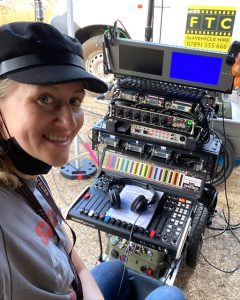 Nina rice has become the audio admiral of a fleet of films envisioned, created, and narratively driven by women. Her credits include the summer blockbuster Barbie, along with Persuasion, This Is Going To Hurt, and November’s psychological thriller Saltburn (directed by Greta Gerwig, Carrie Cracknell, Lucy Forbes, and Oscar-winner Emerald Fennell, respectively), as well as several episodes of historical drama The Crown, which chronicles the reign of Queen Elizabeth II. She spoke to us about the role Lectrosonics Digital Hybrid Wireless has played in ensuring flawless audio across her body of work, with her equipment including a bevy of SSM micro-compact transmitters, legacy SMB transmitters, HMa plug-on transmitters for boom and plant mics, and SRc receivers alongside their predecessor the SRb.“I started at the bottom, so to speak,” Rice recalls about her early career. “I went to the National Film and Television School at Beaconsfield back in 2010. I was in TV drama for a bit, but I also worked on my own documentaries, including one in Chicago called Dream Catchers. Then, I assisted in sound on The Crown, then worked my way up to boom operator, then mixing second unit.”
Nina rice has become the audio admiral of a fleet of films envisioned, created, and narratively driven by women. Her credits include the summer blockbuster Barbie, along with Persuasion, This Is Going To Hurt, and November’s psychological thriller Saltburn (directed by Greta Gerwig, Carrie Cracknell, Lucy Forbes, and Oscar-winner Emerald Fennell, respectively), as well as several episodes of historical drama The Crown, which chronicles the reign of Queen Elizabeth II. She spoke to us about the role Lectrosonics Digital Hybrid Wireless has played in ensuring flawless audio across her body of work, with her equipment including a bevy of SSM micro-compact transmitters, legacy SMB transmitters, HMa plug-on transmitters for boom and plant mics, and SRc receivers alongside their predecessor the SRb.“I started at the bottom, so to speak,” Rice recalls about her early career. “I went to the National Film and Television School at Beaconsfield back in 2010. I was in TV drama for a bit, but I also worked on my own documentaries, including one in Chicago called Dream Catchers. Then, I assisted in sound on The Crown, then worked my way up to boom operator, then mixing second unit.”
Her journey with Lectrosonics started on a documentary series shot in Japan called Becoming You. “It’s about the first 2,000 days of childhood from birth and it included a lot of small children,” says Rice. “That’s why I love the SSM — they’re tiny and easy to hide.”
Sometimes adult wardrobes also provide sparse real estate for hiding transmitters, such as in films with focal beach scenes. “We work very closely with costumers to come up with solutions for hiding transmitters on artists. The size of the SSM gives us that flexibility — we recently even sewed a mic and SSM pack into a massive wig for a prominent lead actress.”
Song-and-dance numbers combining movement and dialogue may also call for the SSM’s diminutive size. “We had two packs sewn into a lead actor’s big fur coat for a musical number that’s pivotal to a recent film,” explains Rice. “One had the gain set low for the shouts, to avoid overloads; another SSM was set with higher gain to capture the whispers and quieter dialogue. Nonetheless, even a single SSM handles a wide dynamic range very well. That’s why the actor wore a third pack for when he takes his coat off during the sequence.”
A tiny footprint is usually at odds with battery life, but Rice found the SSM offered the best of both worlds. “We only need to change the LB-50 batteries in the SSMs once a day — at lunch, usually,” she notes. “This means we don’t have to disturb artists as much.”
In films with large casts, the sheer numbers necessitate careful frequency coordination. “I have had up to 18 channels of wireless going at times,” says Rice. “With the width of spectrum now being taken up by things like 5G service, you need to have your wits about you and test everything. For that reason, I love the flexibility of Lectrosonics and especially the 3rd party LectroRM app, which lets me remotely control transmitter packs so, again, I don’t have to engage artists on set.”
Moviegoers may not actively notice the natural quality of both spoken dialogue and sung passages in Rice’s work, which of course means her equipment is doing its job perfectly. “I’ve done tests before, recording things from whispers to shouts, using the same actor and microphone,” she says. “Not only do I find the audio quality excellent, but it’s my team who have to be most hands-on — they’re the ones placing packs on the actors — and they’re constantly singing their praises. I was struck by the consistency of the audio whether using a current-model pack or a legacy one; it was fantastic across the board.”
Read the full interview with Nina Rice on the Lectrosonics website.





